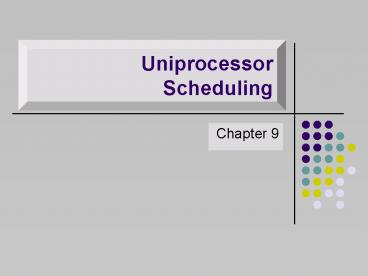Uniprocessor Scheduling - PowerPoint PPT Presentation
1 / 17
Title:
Uniprocessor Scheduling
Description:
Process Scheduling Example. Preemptive version of shortest ... Multilevel feedback using round robin within each of the priority queues. 1-second preemption. ... – PowerPoint PPT presentation
Number of Views:166
Avg rating:3.0/5.0
Title: Uniprocessor Scheduling
1
Uniprocessor Scheduling
- Chapter 9
2
Aim of Scheduling
- To improve
- Response time time it takes a system to react to
a given input - Turnaround Time (TAT) Total time spent in the
system -
waiting time service time - Throughput jobs per minute (inverse of TAT)
3
Types of Scheduling
4
Long-Term Scheduling
- Determines which programs are admitted to the
system for processing - Controls the degree of multiprogramming
- More processes, smaller percentage of time each
process is executed - Which job to admit? FCFS, Priority, expected
exec time, I/O req.s
Medium-Term Scheduling
- Part of the swapping function
- Swapping-in decision is based on the need to
manage the degree of multiprogramming
Short-Term Scheduling
- Known as the dispatcher
- Executes most frequently
- Invoked when an event occurs Clock interrupts,
I/O, OS calls, Signals, etc.
5
Evaluation Criteria for Short-Term Scheduling
Policies
- User-oriented, performance related
- Turnaround time time between submission and
completion - Response Time time between submission and the
first output. - User-oriented, other
- Predictability runs the same way (Time cost)
regardless of the system load - System-oriented, Performance related
- Maximize Throughput rate at which processes are
completed - Processor utilization percentage of time that
the processor is busy - System-oriented, other
- Fairness
- Enforcing priorities?
- Balancing resources? Is it favoring processes
that do not request stressed resources?
6
Priorities
- Scheduler chooses a process of higher priority
over one of lower priority - Use multiple ready queues to represent each level
of priority - Lower-priority may suffer starvation
- allow a process to change its priority based on
its age or execution history
Decision Mode
- Nonpreemptive
- Once a process is in the running state, it will
continue until it terminates or blocks itself - Preemptive
- Currently running process may be interrupted and
moved to the Ready state due to an external
event. - No single process can monopolize the processor
for very long ? Better service
7
Process Scheduling Example
8
First-Come-First-Served (FCFS)
A
B
C
D
E
- Each process joins the Ready queue
- Nonpreemptive
- The oldest process in the ready queue is selected
to run next - Disadvantage
- A short process may have to wait a very long
time before it can execute - Advantage Favors CPU-bound processes
- I/O processes have to wait until CPU-bound
process completes
9
Round-Robin (RR)
A
B
C
D
E
- Preemption based on a clock (time slicing)
- Clock interrupt is generated at periodic
intervals (time slice is determined a priori) - When an interrupt occurs, the currently running
process is placed in the ready queue and next
ready job is selected to run
10
Shortest Process Next (SPN)
- Nonpreemptive
- Process with shortest expected processing time is
selected next. - For batch jobs, user is required to estimate the
running time. If estimated time for process not
correct, the OS may abort it. - For interactive jobs, OS tries to predict it.
- Short process jumps ahead of longer processes
- Possibility of starvation for longer processes
11
Process Scheduling Example
12
Shortest Remaining Time (SRT)
- Preemptive version of shortest process next
policy - Achieves better turnaround time as compared to
SPN, because a short job is given immediate
preference to a running longer job - Risk of starvation for long jobs
- Must estimate the remaining processing time ? Not
easy!
13
Highest Response Ratio Next (HRRN)
A
B
C
D
E
- Nonpreemptive
- An important performance criteria to minimize is
- Normalized TurnAround Time TAT /
ServiceTime - Choose next process with the highest response
ratio R (so that it does not get any higher!)
14
Feedback (FB)
- Hard to predict the remaining time a process
needs to execute. - Instead, we can penalize jobs that have been
running longer - Each subsequent time that a job is preempted, it
is moved to a lower-priority ready queue. This
way, a longer process will gradually drift
downward in the hierarchy of queues. - starvation may occur if new jobs enter the system
frequently
15
A Comparison of Scheduling Policies
16
Characteristics of Various Scheduling Policies
17
Traditional UNIX Scheduling
- Designed to provide good response time for
interactive users while ensuring that
low-priority background jobs do not starve - Multilevel feedback using round robin within each
of the priority queues. 1-second preemption. - Priorities are recomputed once per second.
- It is based on process type and execution history
- In decreasing order of priority, the bands are as
follows - Swapper
- Block I/O device control
- File manipulation
- Character I/O device control
- User processes































